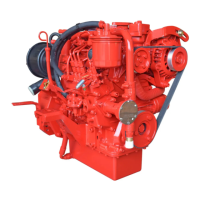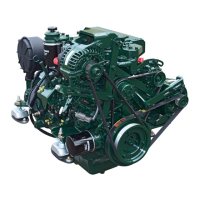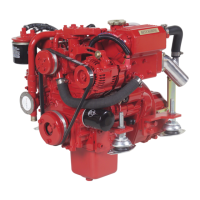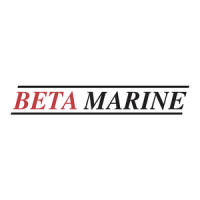Do you have a question about the Beta Marine Beta 43 and is the answer not in the manual?
Engine identification using WOC or serial number for parts and service.
Guards and protection for rotating engine parts.
Safety measures for hot exhaust gases and pipes.
Precautions regarding fuel lines, leaks, and pressure.
Procedures for checking and handling engine oil safely.
Warning about hot coolant and pressure cap removal.
Guidelines for safely moving and lifting the engine.
Manufacturer's disclaimers and craft safety compliance notes.
Details on cylinders, bore, stroke, displacement, power, and torque.
Information on dry weight, sump capacity, and coolant volume.
Details on electrical system voltage, starter output, fuel, and coolant.
Permissible installation angles and engine rotation direction.
General advice for engine installation in marine craft.
Importance and methods for engine compartment ventilation.
Correct positioning and securing of engine flexible mounts.
Ensuring correct angular alignment between engine and propeller shaft.
Ensuring correct parallel alignment between engine and propeller shaft.
Limits and measurement of exhaust back pressure.
Surface area, baffle, and tank profile requirements for skin tanks.
Installation and safety considerations for fuel supply and return lines.
Battery size, condition, and terminal maintenance recommendations.
Sizing and installation of battery cables to minimize voltage drop.
Essential checks before starting a new engine for the first time.
Procedure for removing air from the fuel system.
Operation and indicators for key switch controlled panels.
Summary of maintenance tasks based on running hours or time.
Routine checks to be performed every 8 hours of operation.
Specific maintenance tasks required after the initial 25 hours of use.
Maintenance tasks to be completed after the first 50 hours of operation.
Maintenance tasks required at 150 hours, including shallow sump.
Regular maintenance tasks performed yearly or every 250 hours.
Major maintenance tasks performed every 750 hours.
Specifications for engine oil and coolant, including temperature charts.
Procedure for correctly checking the engine oil level.
Steps for replacing the engine's fuel filter.
Adjusting tension for the polyvee belt driving the alternator.
Belt tension adjustment for secondary alternators.
General electrical system care, including panel protection and battery checks.
Steps to protect the engine during winter or extended storage.
Procedures for preparing the engine for storage out of water.
Solutions for engine starting issues when the starter motor operates.
Troubleshooting steps for a weak or non-functioning starter motor.
Introduction to electrical fault diagnosis for engine ranges.
Specifics for heat exchanger cooled engine electrical systems.
Specifics for keel cooled engine electrical systems.
Torque specifications for standard nuts and bolts.
Torque specifications for special grade nuts and bolts.
Torque settings for specific engine components (e.g., cylinder head).
Manufacturer's statement of compliance with EU emission directives.
| Engine Type | Diesel |
|---|---|
| Power Output | 43 hp (32 kW) |
| Cylinders | 4 |
| Aspiration | Naturally Aspirated |
| Compression Ratio | 23:1 |
| Fuel System | Indirect injection |
| Cooling System | Heat exchanger |
| Maximum Power | 43 hp at 3000 rpm |
| Bore | 84 mm |











